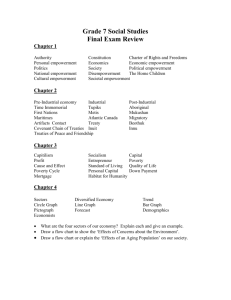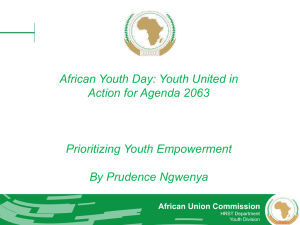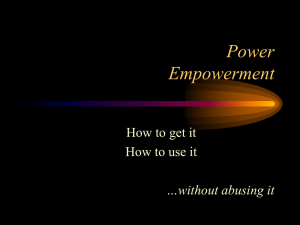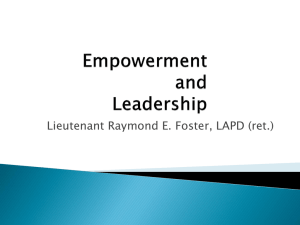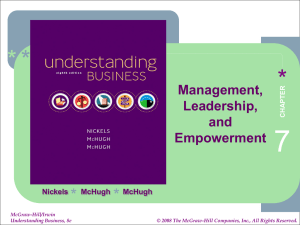Introduction to Power and Influence Theories
advertisement
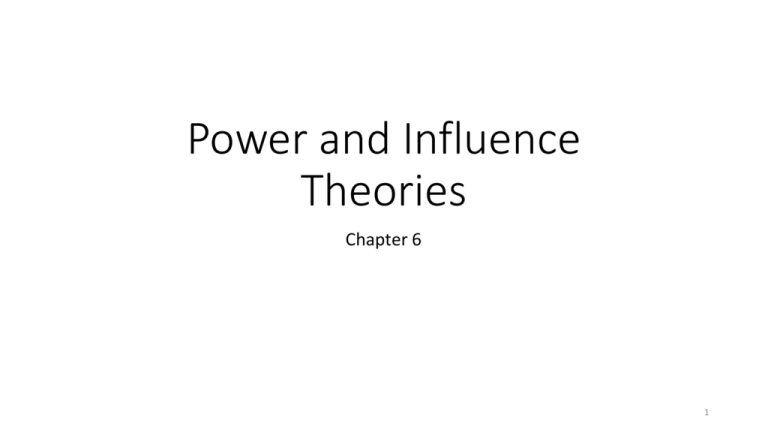
Power and Influence Theories Chapter 6 1 Chapter 6: The Main Idea Leadership 2 Power Influence Types of Power Position Power Personal Power Reward Coercive Legitimate Expert Referent 11 Methods of Influence The Social Exchange Theory When one party uses power, another party experiences a form of loss Empowerment Introduction to Power and Influence Theories • Everyone uses power and influence • They are both important to leadership • At times the differences between power and influence are small • Power and influence are often confused with one another • In the past (tribal, classical, pre-classical eras) power was seen as an effective tool to gain compliance • Today (progressive, post-progressive eras), influence is seen as a better option • Failure to understand the differences between power and leadership can have bad effects 3 Elements of Power • Use of power has been long confused with leadership • Since primitive times (such as the tribal era), leaders who used brute power were considered successful • Many definitions of power • Control, manipulation, deceit, lack of free choice • Power is a relationship between people – transacted 4 5 Two Types of Power: 1. Two broad categories of power: • Position power comes from resources or formal organizational control • Personal power emerges from relationships and is more mature 2. Experienced leaders often resort to personal power rather than position power 6 Position Power Stimuli = something that generates a response. • Reward power – trading positive stimuli for a desired behavior • Coercive power – ability to stop negative consequences in return for a desired behavior • Legitimate power – perception of authority and status in an organization Personal Power • Expert power – derived from the perception that a person has expert knowledge about a particular field or subject • Referent power – occurs when people create strong professional bonds of mutual respect 7 5 Ways Power is Created • Ownership or investment • Popularity or charisma • Possession of resources • Access to opportunities • Association, connections, or networks 8 Social Exchange Theory There are two main points: •People with more power generally able to get more out of an exchange than those holding less power. •People measure the desirability of outcomes by comparing the costs and benefits of using power. When one party uses power, another party experiences a form of loss 9 Elements of Influence • Leaders are agents of influence • Influence requires freewill • Lack of freewill is coercion • Freewill is perceptual • Influence comes from three basic sources • Competency and knowledge • Character and trust • Dynamism and charisma • Leaders and followers should strive to maximize all three basic sources 10 11 11 Tactics for Influence • Rational persuasion • Personal Appeal • Apprising • Ingratiation • Inspirational Appeals • Legitimating tactics • Consultation • Pressure • Exchange • Coalition tactics • Collaboration Empowerment • Empowerment is one of the newest influence methods utilized. • Empowerment is facilitating followers personal motivation by giving them control over their projects. • Empowerment pushes control down to the level where it really belongs – those doing the project. • Empowerment has been a popular buzzword of the 1990s. • It is common for management to endorse empowerment, but to fail to follow through on it. • There are many advantages and some disadvantages to empowerment. However, empowerment generally brings more positive outcomes. 12 13 To make empowering more effective… • Negotiate responsibilities in the beginning • Give authority equal to the responsibilities negotiated • Communicate what is expected • Provide necessary information, feedback, and resources for success • Trust project participants • Demonstrate continuing respect for participants




